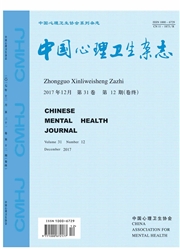

 中文摘要:
中文摘要:
目的:了解医生工作家庭冲突的现状及社会支持、制度支持对工作家庭冲突的影响。方法:采用多阶段分层随机抽样,抽取山东、湖北、河北和内蒙古自治区的公立医院医生。用自编工作家庭冲突-支持量表进行调查。发放量表6070份,回收有效量表5677份,有效回收率为95.6%。对数据进行描述性分析、路径分析。结果:5677名医生的工作-家庭冲突得分高于家庭-工作冲突[(3.4±1.0)vs.(2.8±1.0),P〈0.001];男性的工作-家庭冲突、家庭-工作冲突和冲突压力得分均高于女性[(3.5±1.0)vs.(3.3±1.0),(2.9±1.0)vs.(2.6±1.0),(3.3±1.0)vs.(3.2±1.0);均P〈0.001]。工作政策、休班安排负向预测工作-家庭冲突(β=-0.230,-0.151;P〈0.01),亲友支持和同事支持正向预测工作-家庭冲突(β=0.107,0.060;P〈0.01);亲友支持、同事支持和值班安排负向预测家庭-工作冲突(β=-0.086,-0.041,-0.054,P〈0.05),领导支持和工作政策支持正向预测家庭-工作冲突(β=0.037,0.103,P〈0.05);工作-家庭冲突比家庭-工作冲突对冲突压力有更好的预测作用(β=0.635,0.166,P〈0.01)。结论:公立医院医生工作和家庭角色的冲突较为严重,工作-家庭冲突比家庭-工作冲突更严重,男性比女性医生报告更高的冲突;私人领域的支持可以缓解家庭-工作冲突,组织提供的制度支持能缓解工作-家庭冲突,跨越边界的支持反而加重了医生的冲突感;两种冲突都能导致更高的角色冲突压力,但工作-家庭冲突的效应更大。
 英文摘要:
英文摘要:
Objective: To explore the current status of work-family conflict and effects of social and policy supports on work-family conflict. Methods: The valid samples included 5677 physicians from public hospitals in Shandang, Neimenggu, Hebei and Hubei provinces, who were investigated with a self-compiled scale. Data were analyzed by descriptive analysis and path-analysis. Results: The score of work-to-family ( W→F ) conflict was higher than that of family-to-work ( F→W ) conflict [ ( 3.4 ±1.0 ) vs. ( 2. 8 ± 1.0 ) ; P 〈 0. 001 ] . Male respondents reported a higher level of W→F conflict, F→W conflict and conflict stress than females [ ( 3.5 ± 1.0 ) vs. ( 3.3 ± 1.0 ), ( 2.9 ± 1.0 ) vs. ( 2.6 ± 1.0), ( 3.3 ± 1.0 ) vs. ( 3.2 ± 1.0 ) ; P 〈 0. 001 ] . Working policy and vacation arrangement negatively predicted W→F conflict ( β = -0. 230, -0. 151 ; P 〈0. 01 ), while family/friend support and coworker support positively predicted W→F conflict (β = 0. 107, 0. 060 ; P 〈 0. 01 ) . Family/friend support, coworker support and on-duty arrangement negatively predicted F→W conflict ( β = - 0. 086, -0. 041 and - 0. 054 ; P 〈 0. 05 ), while supervi- sor support and working policy positively predicted F→W conflict ( β = 0. 037, 0. 103 ; P 〈 0. 05 ) . Both W→F and F→W conflicts positively predicted role conflict pressure ( β = 0. 635, 0. 166 ; P 〈 0. 01 ) . Conclusion : Physicians in public hospitals suffer serious work-family conflict, and W→F conflict has a higher level than F→W conflict. Males suffer more serious work-family conflict than females. There is an obvious border between two kinds of conflicts about effective easing means. Informal support from private field can ease F→W conflict, and formal policy support can ease W→F conflict. Supports across the border can increase perceived work-family conflict. Both W→F and F→W conflictscan increase role conflict pressure, but the former have more prominent eff
 同期刊论文项目
同期刊论文项目
 同项目期刊论文
同项目期刊论文
 期刊信息
期刊信息
